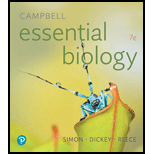
Concept explainers
You look into a microscope and view an unknown cell. What might you see that would tell you whether the cell is prokaryotic or eukaryotic?
- a. a rigid cell wall
- b. a nucleus
- c. a plasma membrane
- d. ribosomes
Introduction:
The cell can be defined as the functional, structural, and building unit of the living organisms. Basically, all the cells that exist on the Earth can be categorized into two different kinds, namely prokaryotes and eukaryotes.
Answer to Problem 1SQ
Correct answer:
Prokaryotic cells lack the double membrane structures, whereas eukaryotic cells possess double membrane–bound organelles such as the nucleus. Therefore, option b. is correct.
Explanation of Solution
Reasons for the correct statement:
All the cells have deoxyribonucleic acid (DNA) as the genetic material. DNA in prokaryotic cells is confined to a small region known as the nucleoid, and it is not membrane bound.
Eukaryotes have double membrane–bound structures including the nucleus, whereas prokaryotes lack any double membrane–bound structure. The membrane surrounding the nucleus is known as the nuclear membrane. The majority of the genetic material of eukaryotes is confined inside the nucleus.
Option b. is given as “a nucleus”.
The statement, “the nucleus is the structure which is present in the eukaryotes and not in the prokaryotes” is the right answer.
Hence, option b. is correct.
Reasons for the incorrect statements:
Option a. is given as “a rigid cell wall”.
A cell wall is a structure surrounding the cell and it provides the structural support to a cell. It is present in most of the prokaryotes and in some eukaryotes, including algae, fungi, and plants. Hence, it is a wrong answer.
Option c. is given as “a plasma membrane”.
The plasma membrane is a selectively permeable structure, which separates the exterior of the cell from the interior. Both prokaryotes and eukaryotes possess the plasma membrane. Hence, it is a wrong answer.
Option d. is given as “ribosomes”.
Ribosomes are the structures that are composed of ribonucleic acid (RNA) and proteins. Ribosomes play role in the synthesis of proteins. Prokaryotes have 70S (sedimentation coefficient) ribosomes, whereas eukaryotes have 80S ribosomes. Hence, it is a wrong answer.
Hence, options a, c, and d are incorrect.
The nucleus is present only in the eukaryotic cells and this double membrane–bound organelle is absent in prokaryotic cells. Thus, the presence of a nucleus can be utilized as a distinguishing feature to determine whether the unknown cell viewed under a microscope is prokaryotic or eukaryotic.
Want to see more full solutions like this?
Chapter 4 Solutions
Campbell Essential Biology (7th Edition)
Additional Science Textbook Solutions
Laboratory Manual for Holes Human Anatomy & Physiology Fetal Pig Version
Human Anatomy & Physiology
Biological Science (6th Edition)
Microbiology with Diseases by Body System (4th Edition)
Microbiology Fundamentals: A Clinical Approach - Standalone book
- A scientist is studying a cell that has a membrane-bound nucleus and a cell wall but lacks chloroplasts. Which kind of cell is the scientist studying?arrow_forwardWhich is true of Prokaryote cells? A) Because their DNA exists in a nucleoid area, the synthesis of proteins depends on random interactions between mRNA and rRNA, B) They contain membrane-bounded compartments or organelles. C) A true nucleus contains the DNA in the form of chromosomes D) Some contain mitochondria E) They contain many organelles in the cytoplasmarrow_forwardWhat is the function of a cell wall?Single choice. A. to protect and support the cell B. to perform different functions in each cell C. to prevent water from passing through itarrow_forward
- Compare and contrast plant cell from animal cell.arrow_forwardA student explains that plant cells have cell walls but not cell membranes, while animal cells have cell membranes but not cell walls. What is wrong with this statement?arrow_forwardIn order to isolate the DNA or RNA from the cells, what would be the first step? a. to block the mucleus from digesting the nucleic acid b.To precipiate the nucleic acid c. To break down the plasma membrane and the cell walls (plant cells) d.To remove protiens from the solutionsarrow_forward
- Briefly tell what organelles are, then give some information about why they are called inner membrane systems. What can you say about the existence of organelles in prokaryotes and to compensate for the functions occurring in the organelle?arrow_forward3. A cell type that contain chloroplast and cell wall. a.Plant cell b. animal cell c. Bacteria cellarrow_forwardWhat characteristic of mitochondria and chloroplasts makes themdifferent from other organelles and suggests they were onceindependent organisms?a. They have a specialized function in the cell.b. They are surrounded by a membrane.c. They contain enzymes.d. They have their own DNA and ribosomes.arrow_forward
- Which statement best explains why the third domain, Archea, was added to the original two domains of Bacteria and Eukarya? A. scientist discovered that eukaryotes are unicellular B. scientist discovered that eukaryotes have cell walls C. scientists discovered that some prokaryotes have cell walls D. scientists discovered that some prokaryotes live in extreme environmentsarrow_forwardWhat might happen if cells did not have microtubulesarrow_forwardWhich of the following would have been found in an early prokaryotic cell? a membrane-bound organelles b nucleus c chloroplasts d DNAarrow_forward
